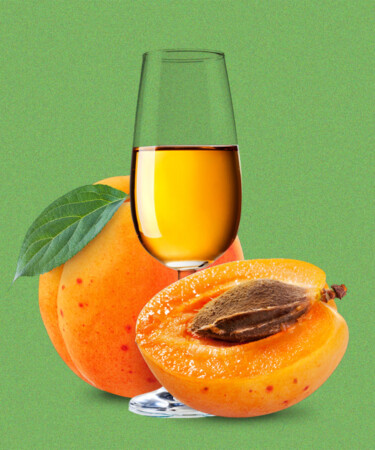Whether first encountered as a sip sneaked from nonna’s dusty liquor cabinet, in a post-meal boozy coffee, or in a classic cocktail, most drinkers have enjoyed amaretto at one point or another. The Italian liqueur is sweet, easygoing, and most would agree that its chief tasting note is almond.
Given that amaretto hits like liquid marzipan and bears a name that could appear to be a nod to almonds, the obvious assumption would be that amaretto’s base ingredient is, well, almonds. But the liqueur isn’t chock- full of nuts like one might think.
The star ingredients in most amarettos are actually stone fruit pits — specifically apricot kernels and peach pits. But why do producers use fruit pits over almonds? And how can they harness such an almond-forward profile without using any almonds? The answers lie in two compounds: benzaldehyde and amygdalin.
The latter is found in peach seeds, apricot kernels, apple seeds, cherry pits, and bitter almonds, which, unlike sweet almonds, aren’t available in the U.S. When amygdalin comes into contact with water, it releases benzaldehyde, which has an aroma and flavor often compared to almonds, marzipan, and cherries. When we ingest amygdalin, our bodies also convert it into the toxin cyanide. But thankfully, amaretto producers take measures to remove any cyanide from the mix during the distillation process. The same situation plays out in the modern production of crème de noyaux, a French stone fruit pit liqueur that used to contain trace levels of the toxin.
To make amaretto, producers steep their amygdalin- and benzaldehyde-rich ingredients in a base spirit — traditionally brandy — and then sweeten the liquid with caramelized sugar. Many brands also add herbs, spices, and other botanicals.
As for the name “amaretto,” it’s not a reference to almonds at all. Rather, it’s the Italian translation of the phrase “a little bitter.” Just as “amaro” means “bitter,” the word “amaretto” is simply a description of the liqueur’s flavor.
Even if we look back at the origin story of amaretto, almonds were never part of the equation. In 1525, Leonardo da Vinci’s pupil Bernardino Luini was commissioned to fresco the Chapel Santa Maria delle Grazie in the Italian town of Saronno. Allegedly, he asked a local innkeeper to be a model for his portrait of the Madonna of the Miracles. Legend has it that the innkeeper gave Luini a flask filled with an amber liqueur as a gift of gratitude, and the recipe for the liqueur was discovered by Saronno’s Reina family the following century. The Reinas would go on to use that same recipe to produce and sell Amaretto di Saronno (now Disaronno Originale) at their local grocery store in the early 1900s. Since then, the liqueur has become the best-selling amaretto in the world, and it’s currently available in over 160 countries. It gets its flavor from apricot kernel oil and “the pure essence of 17 selected herbs and fruits,” but it doesn’t contain any almonds.
There are some companies that do use almonds as their base ingredient, such as Gruppo Caffo and Amaretto ADRIATICO. However, most brands opt for stone fruit seeds. Some brands, like Gozio, list a combination of bitter almonds and stone fruits in their recipes. And others even use Amaretti Chiostro di Saronno cookies, which either contain no almonds or just trace quantities of the nut depending on the type of cookie. So while almonds do make the occasional appearance in amarettos, their inclusion is by no means traditional or obligatory.
